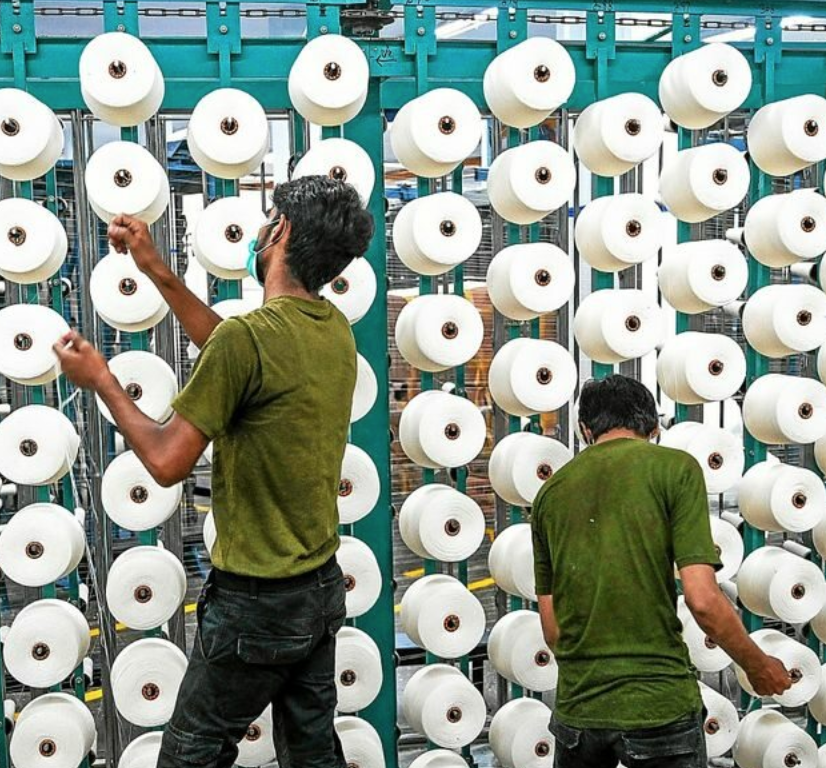
“We’ve worked in factories for years (…) The day you’re sacked, that’s the end of the story,” the 43-year-old, who lives in Lahore (central-eastern India), told AFP.
“We women hugged each other and shouted. The big question was: ‘What are we going to do now? Even when we were working, we couldn’t meet all our household expenses”, says this mother of three.
The Pakistani textile industry, like others, has suffered from the slowdown in global consumption and the rise in energy costs following the outbreak of war in Ukraine.
But the difficulties of the sector, which accounts for 60% of Pakistan’s total exports, have been compounded by the critical state of the national economy, with a balance of payments crisis and a huge debt burden, and by several months of political chaos.
Pakistan, which has come through the Covid period better than others, had seen its textile exports increase by 25% in 2021-2022. But in 2022-2023, they have fallen by 15% to 16.5 billion dollars.
“Two years ago, we were on a trajectory of very strong growth (…) We were convinced that our exports this year would reach 25 billion dollars”, Hamid Zaman, Managing Director of Sarena Textile Industries, told AFP.
“Unfortunately, when you have political instability, when things are not clear, when government policies are reversed, everything goes wrong”, he added.
The textile and clothing sector employs around 8 million people, or 40% of the country’s industrial workforce. But many factories have had to close – at least temporarily – in recent months, or are no longer producing at full capacity.
“Thousands are starving
“Perhaps 25% to 30% of all textile factories have closed (…) It is estimated that perhaps 700,000 jobs have been lost in the last year or year and a half”, adds Mr Zaman.
“I tried to find work in another factory, but they told me that they too were laying off workers,” says Lubna. “They said they were no longer receiving orders from abroad.
Today, “life is getting harder every day”, she adds. In her family, “we cook once for two days. And if we don’t have any food, we make do, without complaining”.
“The government must open the textile factories, because there are thousands of others like me who are now starving”, she begs.
After the devastating floods in the summer of 2022, cotton production in Pakistan fell to an all-time low.
The textile industry was unable to compensate by buying from abroad, due to the import freeze imposed by the government at the beginning of the year, to overcome the drastic fall in its foreign exchange reserves and the risk of defaulting on payments.
Thousands of containers filled with raw materials and other goods essential to the country’s industries were held up for months in the southern port of Karachi.
The country finally managed to consolidate its foreign exchange reserves, with the approval in mid-July of a $3 billion loan from the International Monetary Fund (IMF), and financial assistance from Saudi Arabia and the United Arab Emirates.
“Increase exports
“But that’s not a solution, it’s just getting deeper and deeper into debt,” observes Kamran Arshad, managing director of Ghazi Fabrics international.
“The only way to do that is to increase Pakistan’s exports and create an environment that is conducive to investors and business, and that encourages industrial production and activity”, he adds.
One of the conditions of the agreement with the IMF was the end of subsidies to the energy sector. This led to a sharp rise in the cost of electricity, which affected the competitiveness of textile companies, already facing damaging energy shortages.
“We are not asking for subsidies, in fact what we are asking for is regionally competitive energy prices”, stresses Mr Arshad.
“Our main challenge for the future is that our energy prices are substantially higher than those of India, Bangladesh, Sri Lanka, Vietnam and China”, he insists.
Faced with these competitors, Pakistan has lost market share, with its companies also having to contend with interest rates of over 20% to control record inflation.
“Pakistan’s overall market share in the textile and garment industry was nearly 2.25% about two years ago. Now it’s down to around 1.7%,” says Aamir Fayyaz Sheikh, CEO of Kohinoor Mills. “Companies are being penalised by these very high financial costs.”
“After the elections (due by the end of the year), there will be more political clarity and that will help bring more economic stability,” he believes. “We are asking the government to put us on an equal footing with these countries, so that Pakistani industry can compete.”
Read more – Fashion Network
